The rediscovered potential of ‘growing’ instead of ‘making’ drives the emergence of new materialities. This is leading to innovative developments in biotechnologies and Biodesign, both of which are intricately connected and seen as transformative elements in the discourse on sustainability. Biofabricated materials are starting to be evaluated using established sustainability metrics such as life cycle assessment, highlighting their essential role in the circular economy and shedding light on some overlooked process-dependent environmental burdens. At the same time, some biodesigned materials and artefacts are characterised by their ability to transcend the conventional concept of sustainability, embracing the principles of Regenerative Design thanks to the restorative and regenerative potential of living and bioreceptive materials. The study explores the main Biodesign variables, presenting a taxonomy created to comprehensively understand the phenomenon. The resulting findings highlighted the dual nature of Biodesign, which promotes both inner and outer sustainability. These findings gave rise to a conceptual framework defined as ‘Healing Materialities’, developed by the authors to highlight the main Biodesign variables discussed while addressing a broad spectrum of ecological potentials, from conventional to regenerative sustainability. The article discusses the concept of ‘Healing Materialities’, emphasising the role of Biodesign in supporting a profound ecological turn and advocating the adoption of regenerative materials and processes capable of harmonising the long-term needs of both human and non-human entities.
Impact Paper
Healing Materialities: framing Biodesign’s potential for conventional and regenerative sustainability
-
- Published online by Cambridge University Press:
- 14 November 2024, e21
-
- Article
-
- You have access
- Open access
- HTML
- Export citation
Question
How can robust testing, validation processes, and ethical considerations ensure the safety, effectiveness, and necessity of biotechnological devices in transforming neurological rehabilitation?
-
- Published online by Cambridge University Press:
- 24 October 2024, e22
-
- Article
-
- You have access
- Open access
- HTML
- Export citation

